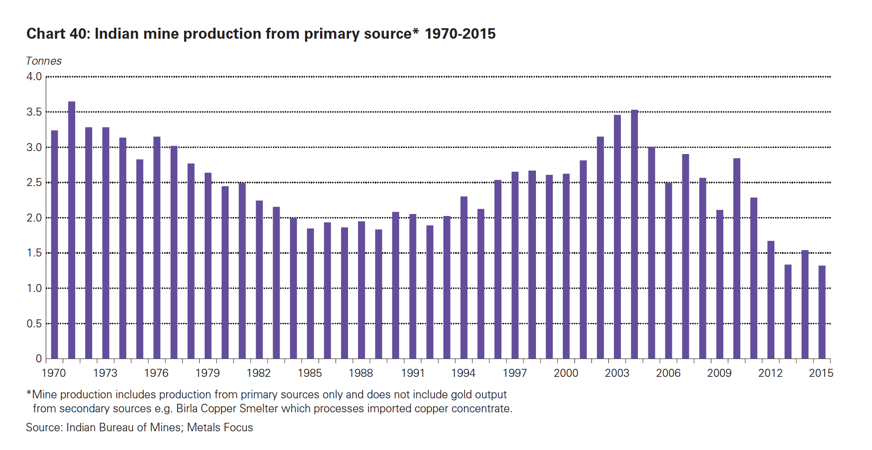India’s minuscule gold mining industry

India’s been the number one source of global gold demand for decades importing close to a 1,000 tonnes in good years.
But, following the closure of the iconic Kolar Gold Field in 2001 after more than 120 years and 800 tonnes or 26 million troy ounces of production, India is home to a single gold mine.
In February 2016, London-listed Vedanta resources became the first private company to successfully bid for a gold mine in India
The Hutti Gold Mine in the southwestern state of Karnataka is also an historic mine (production started in 1902) and located in the same greenstone belt as Kolar.
Hutti produced some 45,000 ounces in 2015 and even after adding gold produced as a byproduct of copper mining on the subcontinent, India’s gold output is little more than 60,000 ounces. The rate of production is also the lowest since at least 1970.

Source: WGC
The World Gold Council on Tuesday issued an in-depth study about India’s deep and multi-faceted relationship with the precious metal, which shows that the Indian government is finally taking some steps to encourage the development of a domestic gold mining industry:
In May 2016, Parliament approved an amendment to the Mines and Minerals (Development and Regulation) Act 1957 (MMDR), which allowed private companies to bid for mining leases via a competitive auction process and proposed that mining leases for major minerals to be granted for a period of 50 years, compared with the previous 30-year limit.
Further amendements were also accepted, under which transfer of captive mining blocks could be allowed without need for auction. Under the initial issue of 43 mining blocks for tender, three are gold mining deposits.
In February 2016, London-listed Vedanta resources became the first private company to successfully bid for a gold mine in India – the Baghmara gold mine in Chhattisgarh – a mine with potential gold reserves of 2.7t of contained metal.
The National Minerals Exploration Policy (NMEP), approved in June 2016, is designed to similarly stimulate mining exploration. The policy allows private companies
to enter into a transparent bidding process, conducted via e-auction, to carry out exploration of mineral-bearing areas.The company submitting the winning bid would be entitled to a share of the royalty paid to the relevant state government. This policy – aimed at accelerating exploration activity – opens the way for the auction of 100 prospective mineral blocks.
The WGC is optimistic that Indian gold production could grow from its low base. In fact production could double this year. Deccan Gold Mines, the sole gold explorer listed in Mumbai, expects to bring its flagship Ganajur project in Karnataka into production in 2017 according to the report. Annual output is estimated at just over 50,000 ounces.

Source: WGC
{{ commodity.name }}
{{ post.title }}
{{ post.date }}




Comments
Hukam Chand Dahiya
Indian Govt need to encourage exploration for metallic minerals, where India spends huge on imports e.g. Gold,